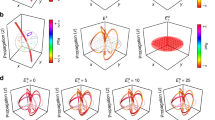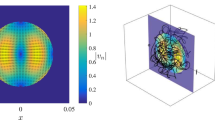Abstract
Knots are topological structures describing how a looped thread can be arranged in space. Although most familiar as knotted material filaments, it is also possible to create knots in singular structures within three-dimensional physical fields such as fluid vortices1 and the nulls of optical fields2,3,4. Here we produce, in the transverse polarization profile of optical beams, knotted lines of circular transverse polarization. We generate and observe both simple torus knots and links as well as the topologically more complicated figure-eight knot. The presence of these knotted polarization singularities endows a nontrivial topological structure on the entire three-dimensional propagating wavefield. In particular, the contours of constant polarization azimuth form Seifert surfaces of high genus5, which we are able to resolve experimentally in a process we call seifertometry. This analysis reveals a level of topological complexity, present in all experimentally generated polarization fields, that goes beyond the conventional reconstruction of polarization singularity lines.
This is a preview of subscription content, access via your institution
Access options
Access Nature and 54 other Nature Portfolio journals
Get Nature+, our best-value online-access subscription
$29.99 / 30 days
cancel any time
Subscribe to this journal
Receive 12 print issues and online access
$209.00 per year
only $17.42 per issue
Buy this article
- Purchase on Springer Link
- Instant access to full article PDF
Prices may be subject to local taxes which are calculated during checkout



Similar content being viewed by others
References
Kleckner, D. & Irvine, W. T. M. Creation and dynamics of knotted vortices. Nat. Phys. 9, 253–258 (2013).
Berry, M. V. & Dennis, M. R. Knotted and linked phase singularities in monochromatic waves. Proc. R. Soc. A 457, 2251–2263 (2001).
Leach, J., Dennis, M. R., Courtial, J. & Padgett, M. J. Laser beams: knotted threads of darkness. Nature 432, 165 (2004).
Dennis, M. R., King, R. P., Jack, B., O’Holleran, K. & Padgett, M. J. Isolated optical vortex knots. Nat. Phys. 6, 118–121 (2010).
Adams, C. C. The Knot Book: An Elementary Introduction to the Mathematical Theory of Knots (American Mathematical Society, Providence, RI, 2004).
Abrikosov, A. A. On the magnetic properties of superconductors of the second group. Sov. Phys. JETP 5, 1174–1182 (1957).
Donnelly, R. J. Experimental Superfluidity (University of Chicago Press, Chicago, 1967).
Nye, J. F. & Berry, M. V. Dislocations in wave trains. Proc. Roy. Soc. A. 336, 165–190 (1974).
Nye, J. F. Natural Focusing and Fine Structure of Light (IoP Publishing, Bristol, 1999).
Dennis, M. R., O’Holleran, K. & Padgett, M. J. in Progress in Optics Vol. 53 (ed. Wolf, E.) 293–363 (Elsevier, Amsterdam, 2009).
Martinez, A. et al. Mutually tangled colloidal knots and induced defect loops in nematic fields. Nat. Mater. 13, 258–263 (2014).
Dennis, M. R. & Bode, B. Constructing a polynomial whose nodal set is the three-twist knot 52. J. Phys. A 50, 265204 (2017).
Bode, B., Dennis, M. R., Foster, D. & King, R. P. Knotted fields and explicit fibrations for lemniscate knots. Proc. R. Soc. A 473, 20160829 (2017).
Nye, J. F. Phase saddles in light beams. J. Opt. 13, 075709 (2011).
Flossmann, F., O’Holleran, K., Dennis, M. R. & Padgett, M. J. Polarization singularities in 2D and 3D speckle fields. Phys. Rev. Lett. 100, 203902 (2008).
Galvez, E. J., Khadka, S., Schubert, W. H. & Nomoto, S. Poincaré-beam patterns produced by nonseparable superpositions of Laguerre–Gauss and polarization modes of light. Appl. Opt. 51, 2925–2934 (2012).
Cardano, F., Karimi, E., Marrucci, L., de Lisio, C. & Santamato, E. Generation and dynamics of optical beams with polarization singularities. Opt. Express 21, 8815–8820 (2013).
Freund, I. Optical Möbius strips in three−dimensional ellipse fields: I. Lines of circular polarization. Opt. Commun. 283, 1–15 (2010).
Bauer, T. et al. Observation of optical polarization Möbius strips. Science 347, 964–966 (2015).
Bauer, T., Neugebauer, M., Leuchs, G. & Banzer, P. Optical polarization Möbius strips and points of purely transverse spin density. Phys. Rev. Lett. 117, 013601 (2016).
Galvez, E. J. et al. Multitwist Möbius strips and twisted ribbons in the polarization of paraxial light beams. Sci. Rep. 7, 13653 (2017).
Garcia-Etxarri, A. Optical polarization Möbius strips on all−dielectric optical scatterers. ACS Photonics 4, 1159–1164 (2017).
Bolduc, E., Bent, N., Santamato, E., Karimi, E., & Boyd, R. W. Exact solution to simultaneous intensity and phase encryption with a single phase-only hologram. Opt. Lett. 38, 3546–3549 (2013).
Taylor, A. J. & other SPOCK contributors. pyknotid knot identification toolkit v0.5.3. https://github.com/SPOCKnots/pyknotid (Accessed 9 May 2018).
Larocque, H. et al. Arbitrary optical wavefront shaping via spin-to-orbit coupling. J. Opt. 18, 124002 (2016).
Romero, J. et al. Entangled optical vortex links. Phys. Rev. Lett. 106, 100407 (2011).
Fickler, R., Lapkiewicz, R., Ramelow, S. & Zeilinger, A. Quantum entanglement of complex photon polarization patterns in vector beams. Phys. Rev. A 89, 060301 (2013).
Karimi, E. et al. Spin–orbit hybrid entanglement of photons and quantum contextuality. Phys. Rev. A 82, 022115 (2010).
Taylor, A. J. & Dennis, M. R. Vortex knots in tangled quantum eigenfunctions. Nat. Commun. 7, 12346 (2016).
Bouchard, F. et al. Polarization shaping for control of nonlinear propagation. Phys. Rev. Lett. 117, 233903 (2016).
Fickler, R. et al. Quantum entanglement of high angular momenta. Science 338, 640–643 (2012).
Padgett, M. J., O’Holleran, K., King, R. P. & Dennis, M. R. Knotted and tangled threads of darkness in light beams. Contemp. Phys. 52, 265–279 (2011).
Lorensen, W. E. & Cline, H. E. Marching cubes: a high resolution 3d surface construction algorithm. ACM Comput. Graph. 21, 163–169 (1987).
Orlandini, E. & Whittington, S. G. Statistical topology of closed curves: some applications in polymer physics. Rev. Mod. Phys. 79, 611–642 (2007).
Acknowledgements
The authors thank F. Bouchard for his advice on using the SLM and P. Banzer for fruitful discussions. This work was supported by Canada Research Chair (CRC) and Canada Foundation for Innovation (CFI). R.F. acknowledges the financial support of the Banting postdoctoral fellowship of the NSERC. E.K. and R.W.B. acknowledge the support of the Canada Excellence Research Chairs (CERC) Program. D.S, A.J.T and M.R.D were supported by the Leverhulme Trust Research Programme grant no. RP2013-K-009, SPOCK: Scientific Properties of Complex Knots.
Author information
Authors and Affiliations
Contributions
H.L. and D.S. designed the holograms used to generate the knots. H.L., D.M. and R.F. performed the experiment. D.S., A.J.T. and M.R.D. performed the topological analysis. R.W.B, M.R.D. and E.K. supervised all aspects of the project. All authors discussed the results and contributed to the text of the manuscript.
Corresponding author
Ethics declarations
Competing interests
The authors declare no competing interests.
Additional information
Publisher’s note: Springer Nature remains neutral with regard to jurisdictional claims in published maps and institutional affiliations.
Supplementary information
Supplementary Information
Supplementary notes, figures and references
Rights and permissions
About this article
Cite this article
Larocque, H., Sugic, D., Mortimer, D. et al. Reconstructing the topology of optical polarization knots. Nature Phys 14, 1079–1082 (2018). https://doi.org/10.1038/s41567-018-0229-2
Received:
Accepted:
Published:
Issue Date:
DOI: https://doi.org/10.1038/s41567-018-0229-2
This article is cited by
-
Topological atom optics and beyond with knotted quantum wavefunctions
Communications Physics (2024)
-
Effects of aberrations on 3D optical topologies
Communications Physics (2023)
-
Scalar optical hopfions
eLight (2022)
-
Revealing the invariance of vectorial structured light in complex media
Nature Photonics (2022)
-
Color-selective three-dimensional polarization structures
Light: Science & Applications (2022)



